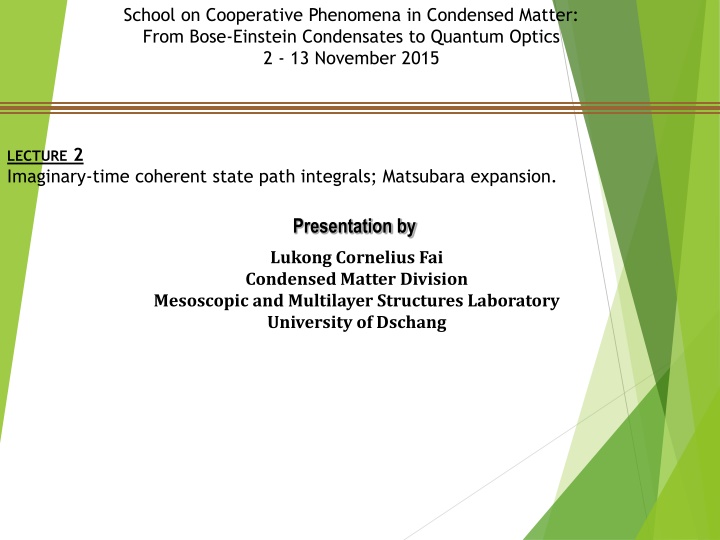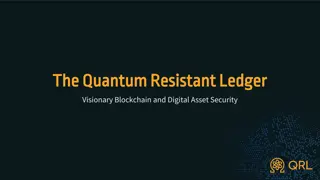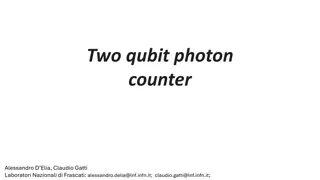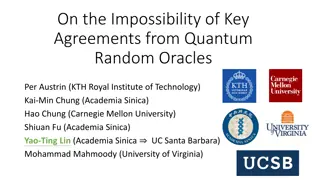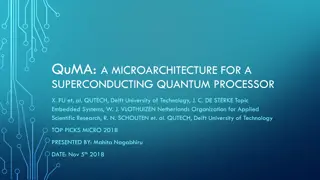Unified Path Integration for Quantum Systems
Setting up a path-integration approach for bosonic and fermionic systems to determine equilibrium properties of quantum fluids at a given temperature. Includes discussions on partition functions and the Feynman path-integral method for quantum mechanics at finite temperatures.
Download Presentation

Please find below an Image/Link to download the presentation.
The content on the website is provided AS IS for your information and personal use only. It may not be sold, licensed, or shared on other websites without obtaining consent from the author.If you encounter any issues during the download, it is possible that the publisher has removed the file from their server.
You are allowed to download the files provided on this website for personal or commercial use, subject to the condition that they are used lawfully. All files are the property of their respective owners.
The content on the website is provided AS IS for your information and personal use only. It may not be sold, licensed, or shared on other websites without obtaining consent from the author.
E N D
Presentation Transcript
School on Cooperative Phenomena in Condensed Matter: From Bose-Einstein Condensates to Quantum Optics 2 - 13 November 2015 LECTURE 2 Imaginary-time coherent state path integrals; Matsubara expansion. Presentation by Lukong Cornelius Fai Condensed Matter Division Mesoscopic and Multilayer Structures Laboratory University of Dschang
2.4 IMAGINARY-TIME COHERENT STATE PATH INTEGRALS We have now all the background to set up a unified path-integration for bosonic and fermionic systems. The path integral approach is a powerful tool considering non- perturbative calculations. Our interest is determining the equilibrium properties of a quantum fluid at some temperature T.
Specifically, since our focus is on statistical mechanics, the required properties can be obtained with the help of the partition function in the grand-canonical ensemble: Z , exp Tr = 1 N = = , T Here, is the Hamiltonian of the system, the chemical potential and N the number operator. We thus need to evaluate this partition function by making use of the quantum field theory and, in addition, the Feynman s path-integral approach to quantum mechanics.
To develop the path integral formalism for the many body problems, it is very convenient to deal directly with finite temperatures and go to imaginary time by doing the change of variable = 0 , i t integral representation of the partition function Z , we time-slice the interval 1 n intermediate points as shown in Figure2. We find the meaning of the Feynman integral ( ) ( ) ( ) q q = 0 through its time-slice definition (Figure 2). [1, 2]. Therefore, to derive the path by , 0 ( ) = = Tr exp exp , Z Dp Dq p q p q d 0 D = n i L 1 n 1 0 FIGURE 2: TIME-SLICE OF THE INTERVAL , 0 1 n BY INTERMEDIATE POINTS.
It is important to note that in phase space, integration over ( ) periodic condition ( ) ( ) q q = 0 slice the expression defining the integral then we have p p , , , 1 0 L momenta integrations and considering the periodic condition Therefore, to have the periodic condition for the integral forZ , we introduce a fictitious variable that is set equal to is restricted by the q whereas the ( ) integration is unrestricted. If we time- q q , , 1 0 L p positions and q = n q , . n p n q 0 n p .
= is the Fermi wave number and From now hence we set the Boltzmann constant. Let us calculate the partition function in the grand-canonical ensemble: ( ) ( ) 1 0 0 0 0 0 exp exp = , where 2 , , , 1 m F B F B ) ( ) ( ( ) ( = = = Tr exp Tr exp exp exp Z L 1 2 1 1 0 n ) exp exp d d L 2 1 1 0 0 n n 2.4.1
We insert a completeness relation 1 jd j j = exp d j j j between all the exponentials in 2.4.1 and consider j + j j , = , exp 1 1 1 j j j and the inner product j j = exp 1 1 j j then we have the products of matrix elements of the form: ( ( 1 1 1 , exp j j j j j j or ( exp j j ( ) ) ( ) ( ) j j j j = = exp 1 1 1 1 1 1 1 1 j j j j j j j j j j 1 ) ) ) ( ( j j j j j = = exp , exp exp , 1 1 1 1 1 1 1 j j j j j j j j j ) ) ( j j exp , 1 1 1 1 1 j j j j j j
Therefore the partition function becomes ( ) j d ) ( 1 n 1 n = j j j j j = + = exp , Z d 1 1 1 j j j j j j = 0 0 j d ( ) 1 n 1 n = j j , d 1 j j j j = + exp , d 1 1 j j j j = 0 0 1 j j ( ) d Letting of time slices yields the following path integral: and in the limit of an infinite number 1 1 j j j j j j j j d ( ) n = = , exp Z d S ( ) 0 = 0 where ( ) ( ) ( ) ( ) , = d + = , , , S 0 is the action functional of the system.
We have seen that all the properties of fermionic coherent states are analogous to the bosonic ones provided , imitate Grassmann variables. Therefore, the path integral for a fermionic system will imitate (formally) that of the bosonic system except that one has to integrate on paths in Grassmann space that are anti-periodic: ( ) = 0 0 where ( is the action functional in Grassmann fields . ( ) n = = , exp Z d d S ) ( ) ( ) ( ) , = d + = , , , , , S r d r r 0
It is instructive to note that for quadratic action functionals the path integration approach can yield only analytical results. Suitable transformations and approximations can bring the action functional to a quadratic form in the desired functional integral over the complex field ( ) with the boundary conditions It is the field theory analogue of the Feynman path integral that is a very versatile tool that has become the main tool in field theory investigation [11]. ( ) 0 ( ) , n = = . , , 0
= To obtain the partition function Z we set and considering the periodic boundary conditions then perform integration over , , 0 n ( ) 0 ( ) , n = = , , 0 then d = , exp Z d S We have so far related the partition function with a functional integral and found that the path integral for a fermionic system is identical (formally) to that of a bosonic system except for the fact that one has to integrate on paths in Grassmann space , say, ( ) ( ) , , , r r that are antiperiodic. We now apply the path integral functional approach to quantum ideal gases.
3.MATSUBARA EXPANSION We consider a particle located in the volume V and described by the Schrodinger equation: = = , Here, is the energy eigen value and the eigen function: ( ) ( ) ( ) r r r , , and , 1 ( ) r ( ) r = = = = , exp i r , , , , V 1 ( ) r = exp r d i r , V Similarly ( ) r ( ) = r ,
The wave function 1 ( ) r = exp i r V obeys respectively the following orthonormality ( ) r ( ) r r = d , , and closure ( ) r ( ) r , ( ) = d r r , relations.
, r ( ) Considering the above we can write the time-dependent function following form: ( ) ( ) ( ) ( ) r r r , , Considering the expansion ( ) , = in the 1 ( ) ( ) r ( ) ( ) r , = = = = , exp i r , , , , V 1 i n exp , , n n Then i n V i exp 1 V exp r r r r ( ) ( ) ( ) ( ) , n , n n n , = = = = , exp , r n , , , , , , 3.1 Similarly, V i n i exp exp r r r ( ) , n , n , = = , 3.2 , n , , , , n n
We required that the reciprocal and space-time ket vectors obey respectively the following relations r r , n 1 = = , , , , n n d r d 0 Therefore, ( ) ( ) = , , = , , , n n r r r r n n From 3.1 and 3.2 we have the following ( ) r r ( ) ( ) n , , i n , , , , n Here, the swapping of the Grassmann variables will result in just a change of the minus sign: ( , , , , n n n i = Consequently ( ) ( ) ( ) i , , , , n n n r r ) ( ) , i , , , , , n n n
We have considered the particles to be located in a domain of volumeV with periodic n = for bosons and ( ) 1 2 + n 2 n = boundary conditions. Here, for fermions are n respectively even and odd Matsubara frequencies. These frequencies are discrete at finite temperatures. However, they are continuous in the limit of zero temperature ( ) when the spacing 2 between adjacent frequencies goes to zero.
3.1.1PATH INTEGRAL APPROACH TO ATOMIC FERMI GASES Considering a crystal, then we have free electrons moving around the atoms and can be described as an electrons gas[12]. The Fermi liquid concept is the deviation of the electron gas from the ideal gas behaviour. This concept was introduced by Lev Davidovich Landau[13] and provides an effective description of interacting fermions.
The partition function method. A detailed knowledge of a quantum ideal gas is an important step in understanding experiments with trapped atomic gases. Z of a quantum ideal gas is an ideal test for the field-theoretical 0 Since direct calculations of the retarded Green functions are impractical at finite ( ) , , ; r r G temperatures, we introduce imaginary-time Green functions technical reasons. It is instructive to note that in the field theory, the term Green function has a different meaning from that in the theory of linear differential equations. for ,
Though the Green function obeys the equation whose right hand side has a Dirac delta function, the equation is in general nonlinear, ( ) = , , ; , r r G or equivalently ( ) = , , ; , r r G L Here L is the Lagrange operator. ( ) ( ) 1 r r L , ( ) ( ) r r ,
For better understanding we examine first the action functional of noninteracting gases and the partition function where ( , , , ; , , = r r r r G ( ) ( ) ( ) , = , , , , 1 ; S d r d d r d r r r r G , 0 0 = , 3.3 exp Z d d S 0 ) ( ) , , , exp d d r r S ( ) ( ) ( ) exp 0 d , d S 0 is the Matsubara Green function both in spin space as well as in coordinate space that bridges the gap between the functional formulation of quantum field theory and the operator formalism; right to left in increasing order of time and is the time ordering operator that places the operators from , 0 S the action functional.
The Gaussian integral 3.3 yields ( ) ( ) = = 1 1 det exp Tr ln Z G G 0 Generally Green functions (connected Green functions) can be obtained from a generative functional which is nothing else than the partition functions with source variables, say, ( ) and ( ) are Grassmann valued: , r , r d ( ) ( ) ( , ) ( ) ( , ) , + , , + , exp d S d r d r r r r 0 0 , = Z d 0 exp d S 0
Considering 3.3, this can be represented as follows = 0 , Z ( ) , , d d + + 1 exp G , . . 3.4 , d d 1 exp G , ) , r , r ( ( ) For the case of fermions, the source variables variables. We displace the argument of the exponential function in equation 3.4 by the following change of variables: + = . , G and are Grassmann = + , G . ,
Then ( ) , d d + 1 exp G G , . , . , , = = exp Z G . , . 0 , , d d 1 exp G , Therefore we recover the Green functions by functional derivatives of the generative functional , 0 Z : 2 , Z ( ) = 0 , ; , r r G ( ) ( ) , , , r r , = = 0 ( 0 , 0 = = = + Here, as indicated earlier, important to note that , where ) 1 and ( , , r G for bosons and for fermions. It is 1 1 1 Z 0 ) ( ) , = , , ; ; r r r G ,
Consider the Fourier transform ( ) = , ; , p where, ( , G between times and . It is instructive to note that difference( ) r r which is a consequence of the homogeneity of space that is satisfied by the free electron model with zero external potential. From equation 3.5, the Green function is also only a function of the time difference ( separately which is a consequence of homogeneity of time. ( ) ( G ) ) ( ) ( ) ( ) n i , , = 3.5 exp , r r r r G G , , n , is the single particle propagator with wave vector ( , r G ) ( i , G n ) , ; depends only on the r ) and not the individual times
1. Fai, L.C. and M. Wysin, Statistical Thermodynamics: Understanding the Properties of Macroscopic Systems. 2012, USA: CRC Press, Taylor & Francis Group. Feynman, R.P. and A.R. Hibbs, Quantum Mechanics and Path Integrals. 1965, New York: McGraw-Hill. Feynman, R.P., Space-Time Approach to Non-Relativistic Quantum Mechanics. Reviews of Modern Physics, 1948. 20(2): p. 367-387. Klauder, J.R. and B.-S. Skagerstam, Coherent states : applications in physics and mathematical physics. 1985, Singapore; Philadelphia: World Scientific. Jaksch, D., et al., Cold Bosonic Atoms in Optical Lattices. Physical Review Letters, 1998. 81(15): p. 3108-3111. Martin, J.L., The Feynman Principle for a Fermi System. Proceedings of the Royal Society of London A: Mathematical, Physical and Engineering Sciences, 1959. 251(1267): p. 543-549. Tempere, J. and J.P. Devreese, Path-integral description of Cooper pairing. 2012: INTECH Open Access Publisher. Nagaosa, N., Quantum Field Theory in Condensed Matter Physics. 1999: Springer. Berezin, F.A., The Method of Second Quantization First ed. Vol. 24. 1966: Academic Press. Zee, A., Quantum Field Theory in a Nutshell. Second edition ed. 2010: Princeton University Press. Ashcroft, N.W. and N.W. Ashcroft, Solid State Physics. First ed. 1976: Saundrers College. Lifshitz , E.M. and L.P. Pitaevskii Statistical Physics, Part 2. Course of Theoretical Physics. Vol. 9. 1980: Pergamon Press. 2. 3. 4. 5. 6. 7. 8. 9. 10. 11. 12.
